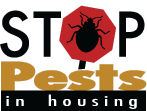Evaluate Your Success
Affordable housing properties have achieved positive results through integrated pest management (IPM) programs by tracking the parameters shown below: cost, health impacts, efficiency, and strategic partnerships. Consider beginning your program with these in mind. The StopPests in Housing Program uses a series of surveys to collect data and assess the efficacy of IPM and our efforts.
Read case studies and explore our research database to see others' success.
Cost
IPM can save both property managers and tenants money. In addition to doing a better job of managing pests, some properties have experienced cost-savings with IPM. Property managers should look at the long-term cost of pest management decisions. Routine pesticide applications do not provide long-term control and rarely solve the pest problem. Keep track of your expenses to justify your IPM program.
- An IPM contract with a licensed pest management professional
- Materials and time for maintenance staff or contractors to seal up holes, cracks, and crevices
- Property manager or resident support service staff time for one-on-one interventions with residents to get their units in compliance with housekeeping standards and pest control preparation instructions
- Free supplies for residents that help them do their part—cleaning supplies, monitors, mattress encasements, etc.
Consider also the benefits, such as whether you've been able to
- Leverage funding (e.g., use a small grant to bring in additional dollars)
- Create employment
- Save money through fewer responses to complaints
- Lower pesticide costs
Health Impacts
Pests such as cockroaches, rodents, and bed bugs are problems. Public health pests can trigger or cause asthma and allergies, contaminate food, violate housing codes, and transmit disease. Many pests lead people to overreact and ignore pesticide labels. Pest and pesticide exposure is particularly risky for vulnerable populations such as children, pregnant women, and the elderly—all of whom live in affordable housing. Infested housing is not safe, decent, or sanitary. The U.S. Department of Housing and Urban Development defines a healthy home as being dry, clean, ventilated, safe, contaminant-free, maintained, and pest-free. An IPM program addresses all of these components.
Consider tracking:
- Amount of pesticide used on the exterior of the property
- Amount of pesticide used in buildings
- Resident satisfaction
- Employee satisfaction
- Health improvement, such as reduction in asthma attacks
- Number of pests caught on monitoring devices
Efficiency
- Decrease in work orders related to pest control
- Improvement in REAC and pest inspection results
- Retention of staff and residents
Strategic partnerships
Everyone can come together on the issue of pest-free housing. Measure resources delivered and obtained through these partnerships to help qualify the property as a community asset.
- Local support agencies can offer resources and expertise to address problems that a property manager may have neither the time nor expertise to deal with. Track resources leveraged through IPM.
- Affordable housing providers are in a good position to become community leaders in pest control. Share your successes and knowledge to other landlords, organizations, and city departments. Host trainings that are open to the community, reach out to home health aides and others who work within your communities, and utilize local media. Track the number of people you reach.
